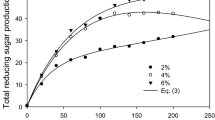Abstract
The acidic hydrolysis of biomass generates numerous inhibitors of fermentation, which adversely affect cell growth and metabolism. The goal of the present study was to determine the effects of fermentation inhibitors on growth and glucose consumption by Saccharomyces cerevisiae. We also conducted in situ adsorption during cell cultivation in synthetic broth containing fermentation inhibitors. In order to evaluate the effect of in situ adsorption on cell growth, five inhibitors, namely 5-hydroxymethylfurfural, levulinic acid, furfural, formic acid, and acetic acid, were introduced into synthetic broth. The existence of fermentation inhibitors during cell culture adversely affects cell growth and sugar consumption. Furfural, formic acid, and acetic acid were the most potent inhibitors in our culture system. The in situ adsorption of inhibitors by the addition of activated charcoal to the synthetic broth increased cell growth and sugar consumption. Our results indicate that detoxification of fermentation media by in situ adsorption may be useful for enhancing biofuel production.





Similar content being viewed by others
References
Berndes G, Hoogwijk M, van den Broek R (2003) The contribution of biomass in the future global energy supply: a review of 17 studies. Biomass Bioenergy 25(1):1–28
Jang JS, Cho YK, Jeong GT, Kim SK (2012) Optimization of saccharification and ethanol production by simultaneous saccharification and fermentation (SSF) from seaweed, Saccharina japonica. Bioprocess Biosyst Eng 35:11–18
Jeong GT, Park DH (2010) Production of sugars and levulinic acid from marine biomass Gelidium amansii. Appl Biochem Biotechnol 161:41–52
Hoekman SK (2009) Biofuels in the U.S.—challenges and opportunities. Renew Energy 34:14–22
Schenk PM, Thomas-Hall SR, Stephens E, Marx UC, Mussgnug JH, Posten C, Kruse F, Hankamer F (2008) Second generation biofuels: high-efficiency microalgae for biodiesel production. Bioenergetic Res 1:20–43
Horn SJ, Aasen IM, Østgaard K (2000) Ethanol production from seaweed extract. J Ind Microbiol Biotechnol 25:249–254
Muffler K, Ulber R (2005) Downstream processing in marine biotechnology. Adv Biochem Eng Biotechnol 97:63–103
Matsunaga T, Takeyama H, Miyashita H, Yokouchi H (2005) Marine microalgae. Adv Biochem Eng Biotechnol 96:165–188
Horn S, Aasen I, Østgaard K (2000) Production of ethanol from mannitol by Zymobacter palmae. J Ind Microbiol Biotechnol 24(1):51–57
Tang JC, Taniguchi H, Chu H, Zhou Q, Nagata S (2009) Isolation and characterization of alginate-degrading bacteria for disposal of seaweed wastes. Lett Appl Microbiol 48(1):38–43
Meinita MDN, Hong YK, Jeong GT (2012) Comparison of sulfuric and hydrochloric acids as catalysts in hydrolysis of Kappaphycus alvarezii (cottonii). Bioprocess Biosyst Eng 35:123–128
Kang KE, Jeong GT, Sunwoo C, Park DH (2012) Pretreatment of rapeseed straw by soaking in aqueous ammonia. Bioprocess Biosyst Eng 35:77–84
Zhu J, Yong Q, Xu Y, Yu S (2011) Detoxification of cornstover prehydrolyzate by trialkylamine extraction to improve the ethanol production with Pichia stipitis CBS 5776. Bioresour Technol 102(2):1663–1668
Singh R, Varma AJ, Laxman RS, Rao M (2009) Hydrolysis of cellulose derived from steam exploded bagasse by Penicillium cellulases: comparison with commercial cellulase. Bioresour Technol 100:6679–6681
Meinita MDN, Hong YK, Jeong GT (2012) Detoxification of acidic catalyzed hydrolysate of Kappaphycus alvarezii (cottonii). Bioprocess Biosyst Eng 35:93–98
Chandel AK, Silva SS, Singh OV (2011) In: Bernardes MAS (ed) Biofuel production-recent developments and prospects, 1st edn. InTech, Croatia
Mussatto SI, Roberto IC (2004) Alternatives for detoxification of diluted-acid lignocellulosic hydrolyzates for use in fermentative processes: a review. Bioresour Technol 93:1–10
Lee H, Cho DH, Kim YW, Shin SJ, Kim SB, Han SO, Lee J, Kim SW, Park C (2011) Tolerance of Saccharomyces cerevisiae K35 to lignocellulose-derived inhibitory compounds. Biotechnol Bioprocess Eng 16(4):755–760
Palmqvist E, Almeida J, Hahn-Hagerdal B (1999) Influence of furfural on anaerobic glycolytic kinetics of Saccharomyces cerevisiae in batch culture. Biotechnol Bioeng 62:447–454
Modig T, Liden G, Taherzadeh MJ (2002) Inhibition effects of furfural on alcohol dehydrogenase, aldehyde dehydrogenase, and pyruvate dehydrogenase. Biochem J 363:769–776
Lee M, Cho DH, Kim YH, Lee J, Lee JH, Kim SW, Cho J, Lee D, Kim S, Park C (2009) Effect of biomass-derived inhibitors on ethanol production. KSBB J 24:439–445
Gorsich SW, Slininger PJ, Mccaffery J (2006) The fermentation inhibitor furfural causes cellular damage to Saccharomyces cerevisiae. In: Proceedings of 28th Symposium on Biotechnology for Fuels and Chemicals, Nashville, USA
Cho DH, Shin SJ, Bae Y, Park C, Kim YH (2010) Enhanced ethanol production from deacetylated yellow poplar acid hydrolysate by Pichia stipitis. Bioresour Technol 101(13):4947–4951
Verduyn C, Postma E, Scheffers WA, Van Dijken JP (1992) Effect of benzoic acid on metabolic fluxes in yeasts: a continuous-culture study on the regulation of respiration and alcoholic fermentation. Yeast 8:501–517
Russell JB (1992) Another explanation for the toxicity of fermentation acids at low pH: anion accumulation versus uncoupling. J Appl Bacteriol 73:363–370
Acknowledgments
This research was supported by a grant from Marine Biotechnology Program Funded by Ministry of Land, Transport and Maritime Affairs of Korean Government.
Author information
Authors and Affiliations
Corresponding authors
Rights and permissions
About this article
Cite this article
Kim, SK., Park, DH., Song, S.H. et al. Effect of fermentation inhibitors in the presence and absence of activated charcoal on the growth of Saccharomyces cerevisiae . Bioprocess Biosyst Eng 36, 659–666 (2013). https://doi.org/10.1007/s00449-013-0888-4
Received:
Accepted:
Published:
Issue Date:
DOI: https://doi.org/10.1007/s00449-013-0888-4




